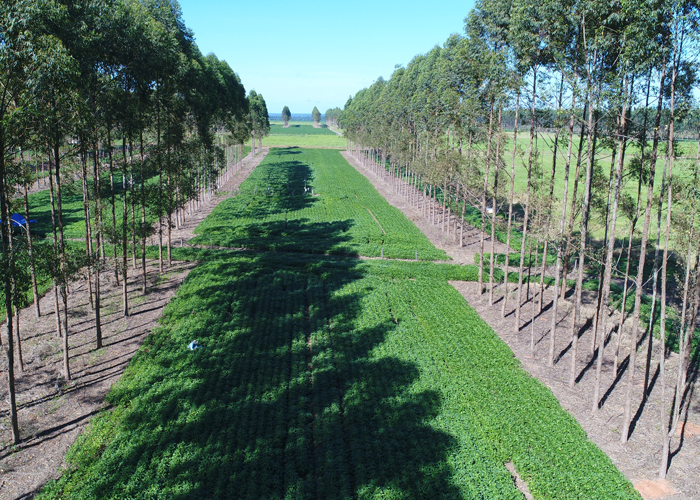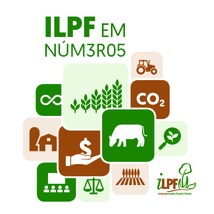 Busca de Notícias
Busca de Notícias
Research shows trees' interference in crops in ICLF systems
Soybeans are more tolerant to tree shade in an integrated crop-livestock-forest (ICLF) system than maize. This is one of the conclusions of the five-year assessment of different configurations of integrated systems conducted in the biggest ICLF experiment led by Embrapa, in Sinop, MT.
According to results published by researchers from Embrapa Agrosilvipastoral (Sinop, Mato Grosso), soybean crops only presented reduced productivity due to lower sun incidence from the fourth year of implementation of the systems. Meanwhile maize, which was cultivated as a second harvest crop, presented a fall in productivity from the third crop year on.
The research was made in an experiment area of 72 hectares, where soybean/maize, beef cattle and eucalyptus production systems have been compared with all the integrated combinations possible: ICL, ICF, ILF and ICLF (with crop rotation every two years, crops in the harvest season and cattle off-season every year). The areas with tree components are formed by triple rows of eucalyptuses, with 30-m spacing in-between, planted from east to west.
As for soybeans, even though there was no difference in plant size until the fourth year, the productivity of the ICF system had a 18.4% fall when compared with the single crop system in the 2014/2015 crop year, the system's fourth one. In the remaining systems with trees there was no statistical difference.
By the end of the fifth crop year (2015/2016), soybean yield had a 24% fall in ICF and ICLF systems with rotation every two years. In the most intensified ICLF system, with soybeans and maize intercropped with Brachiaria, and grazing after the maize harvest, in every year, the productivity of the oilseed was similar to the system without trees.
The maize only started to present statistical differences in the average plant size from the fifth year on, with variation of up to 19 cm in plant height. The cultivation lines that were closer to the trees in the South front were the ones that presented greater reduction. However, variations in productivity had started to be observed in the third harvest, with an average fall of 19% in the treatments with trees, in comparison with the single crop. In the two following harvests, the fall was of 37%.
For the five years of the assessment, the reduction in average productivity for soybean totalled 13.1% in the ICF system and 8.6% in ICLF systems. Meanwhile maize presented an average fall of 23.1% in the ICF and 19.4% in the ICLF system.
“Maize is a demanding plant in terms of light, a C4 plant. And in our region it is cultivated mid-season, the worst time in terms of luminosity. The days are increasingly shorter until the beginning of the winter. On top of that, the trees project longer shades due to the higher sun angle at this time of the year”, explains the researcher Ciro Magalhães.
According to the researcher, the incidence of solar radiation in the systems with trees, when compared with exclusive cropping, was 17% lower in the soybean crop period and 33% lower in the period when the maize was cultivated, data measured throughout the seventh crop year evaluated (2017/18).
The effect of shade in ICLF systems
Should maize be removed from the system?
Despite maize presenting greater fall in productivity, the good management of the forest component can make the continuity of the grain plantation feasible for another one or two harvests.
“Lopping the trees at the highest possible height will enable more light to enter the system as well as reduce tree evapotranspiration. When you remove the leaf surface by pruning the lower branches, you reduces the demand for water, and consequently there will be less competition for water and nutrients between the trees and soybean and maize plants in the zone that is nearest to the rows, a factor that also reduces grain yield”, explains Ciro, who also warns about the need to prune to ensure good timber quality for sawmills.
Another alternative is to plan ICLF systems with simple rows, with a single line of trees. Subsequently to the period assessed in the study, one of the treatments was hewn in order to be with only a central line of trees, in a 37-m spacing. Soybeans immediately recovered their productivity to the same levels of systems without trees. Maize also responded well, recovering part of its productivity. However, it still presented losses when compared with the single crop system.
“If you start an ICLF system with single rows, we know that by the seventh year you can cultivate soybeans without productivity losses. Meanwhile maize, even with single rows, with eucalyptus at six and seven years of age, has losses from 15% to 23%”, Ciro states based on the assessments of the 2016/2017 and 2017/2018 harvests.
To learn the extent to which maize productivity losses will be compensated with the profit from timber trade, it will be necessary to wait until the end of the cycle, with the final tree cutting and the full economic assessment of the system.
In the researcher's opinion, alternatives like cultivating maize in the crop season (time with higher incidence of radiation in the systems) can be interesting as long as the market makes it worth it. Otherwise, it is best to make a rotation with other crops, such as rice and cowpeas, for instance, or anticipate the off-season cattle.
“One of the possible ways of making a better use of the ICLF area would be cultivating soybeans in the crop season and then sowing grass right away. It would be an early off-season cattle production system. In 40 days the grass is formed and the cattle can start grazing in an area with shade, which is provenly beneficial for the performance of the animals”, he suggests.
ICLFS: more income using the same space
Unlike what a superficial analysis of the crop yield can suggest, the research shows that ICLF systems do pay off. In fact, there are positive results in the tree and cattle components.
“You get more than one product in the same area. By their fifth year, in one of the ICLF systems with triple rows, soybean productivity was equivalent to the one in a single-crop system. That is, soybeans are produced with the same productivity and, on top of that, there are trees growing there that can provide income in the future”, Ciro highlights.
According to the research, by the fourth year the trees in the integrated systems behaved similarly to the trees in monoculture, with an average annual increment of 31 m³/ha. The figure is below the national average for Eucalyptus urograndis, of 39 m³/ha, but above the average in Mato Grosso, which is of 23.8 m³/ha/year.
Larger logs in ICLFS
In their fifth year, assessments demonstrated greater gains in diameter in the ICLFS, with an average of 3.8 cm/year as opposed to the 3.2 cm/year obtained in the single forestry system. According to the researcher Hélio Tonini, this is evidence of bigger competition for light in the monoculture.
However, by the fifth year no significant variation in timber volume was identified among the individuals compared.
The continuity of the research, however, has been showing that tree management, including the removal of side lines and maintenance of the central line, has great impact in diameter growth and in volume increases. In two years, the gain in volume within the area with single lines can be 54% greater than in the area with monoculture and 25% greater than the area with rows with triple lines, asserts the Embrapa researcher Maurel Behling.
Better forage and animal performance
Beef cattle farming, in turn, presented gains when it was integrated with the crops and the forest. A mensuração do acúmulo de forragem foi 34% superior nas áreas precedidas por lavoura. Isso se refletiu em maior ganho de peso dos novilhos nelore. Nos sistemas ILPF o ganho de peso médio por animal foi de 740 g/dia, 21% superior à ILP, 38% superior à pastagem exclusiva e 24% superior à IPF.
De acordo com o pesquisador da Embrapa Bruno Pedreira, responsável pela avaliação do componente pecuário, os dados mostram a sinergia dos componentes. “A interação entre eles gera ganhos que muitas vezes nem se consegue identificar onde estão”, afirma o especialista.
Economic assessment
All the data for the economic assessment of this experiment have been collected but not yet fully analyzed. In any case, other studies conducted in partnership between Embrapa, the Mato Grosso Institute of Agricultural Economics (Imea) and ICLFS Network have demonstrated the economic viability of integrated crop-livestock-forestry systems.
A recently published study has in fact demonstrated how such systems contribute to increased security for farmers. By varying the sources of income, they are less vulnerable to possible variations in the prices of commodities.
The work also showed that even in the worst simulated scenarios, with a fall of 15% in the price of soybeans or of live cattle, ICLF systems remain lucrative.
The Embrapa researcher Júlio Cesar dos Reis recalls that in an integrated system, no result should be observed in isolation. It is necessary to look at the system as a whole. The fall in productivity in a component can be mitigated by the gain in another.
Translation: Mariana Medeiros
Gabriel Faria (MTb 15.624/MG)
Embrapa Agrosilvopastoral
Press inquiries
agrossilvipastoril.imprensa@embrapa.br
Phone number: +55 66 3211-4227
Further information on the topic
Citizen Attention Service (SAC)
www.embrapa.br/contact-us/sac/



